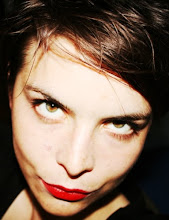I was wondering about the contemporary art scene in Paris: Just a hunch this, but is it (not) rather feeble - big gallery stuff and precious art school posturing - little in the way of democratized art presentations, collectives etc.?
I stand arms spread, heart wide open to correction, for it was some years ago that I was there and I wasn't exactly immersed in the scene, but it seems to be rather different to London or Berlin or New York in that way. In London and Berlin (and from what I've heard, several cities in the States also) you cannot escape contemporary art - underground collectives are actually rather visible, which is to be celebrated (although, in London at least, it has become sadly difficult to distinguish their activities from the work of guerilla advertisers). Not so in Paris : Paris is strangled by the dream of its own history, suffocated by a cultural inheritance that its fetishizers hope to recapture, but the rainbow doesn't end: it is a mirage.
And Berlin? It's pretty amazing how democratic the art scene here is - it seems that if people are prepared to do interesting things, then they will find an audience for it. That's not to say that a some of that interest isn't disingenuous and some of the art, misguided. Opportunities abound, certainly, but I guess the problem is whether or not there's a real audience - an audience that listens. (Audience: ORIGIN Latin audientia, from audire ‘hear’.)
Berlin art is ambient. It suffuses the place, but there's an awkward feeling that it might just be a little self-reflexive, self-congratulating and self-generating: (Ambient: ORIGIN Latin, from ambire ‘go round’.) It stalks the city in circuitous paths, but returns always to itself. It is utopian, occupying the 'no-place' of the imagination. I doubt how deeply it penetrates into the steel and glass edifices of Potsdamer Platz (daily more like the Manhattan Island of central Europe) and the sex clubs by the Ostbahnhof and Janowitzbruecke, where there's a scat night four times a year; naked group sex parties twice a week; anal, deepthroat and fisting every third week of the month; bondage once a fortnight; and piss parties weekly.
A new magazine launches tonight in Berlin - Utopia: http://www.utopiamagazine.org. I was going to go, but I couldn't be bothered, and... well, now it's too late. Again, tonight, the same night, a contemporary art festival opens: New Life Berlin: http://www.wooloo.org. I didn't go to that either - It was at 6pm and I was sleeping.
Still, the vocabulary is illuminating.
But I wonder, is contemporary art disappearing into the abject utopia of the text? With the anguished cry of the wounded animal, art retreats in horror from the modern world into the space of its own moribund imagination and curls up there: In its love affair with interpreting its own history it binds itself to death. If it is not careful, it will die - not of exposure, but enclosure. Shivering and malnourished, it swallows its own tail, before chewing off its hind legs and fore-paws, until, deformed and disease-ridden, it dies finally of starvation. Except that it won't die, because it is already its own ghost. It is un-dead, still living off the corpse of avant-garde theories of the 1920s and 30s, their impact decimated by the crises of that time: all that Baudrillard et. al. did was to lead them to pasture in a climate more hospitable to their reception.
This is the crisis of postmodernism (which I do not capitalize, because in its nature it refutes uniqueness): that we are caught in a cultural moment which does not exist; it is pure text - the dys(u)topia of the modern imagination. We never escaped modernism. We're still there. Postmodernity is not the process of casting off the shackles of the grand narratives of nineteenth century historicism and exploding totalities. It is the state of dreaming itself.
N.B. For the origin of text as utopia, see Louis Marin's Utopiques
